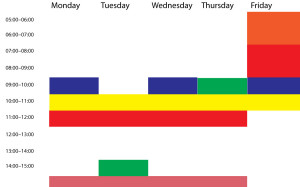It’s fair enough: they want to be as productive you, I expect you’d quite like their money, it could all work out brilliantly. I always think of you as you, the individual you, being as creative and productive as you are, but whether you’re on your own or whether you spend 40-80 hours a week working in a massive international corporation, the things that my Blank Screen book tell you will help. The ideas scale up for you because they’re all really about getting through lots of work and clearing time for you to write. What corporations reportedly want is a way for that to scale up for everyone in their business too.
You’ve heard this before. I worked in the BBC and heard it a lot in myriad different yet also identical ways: lots of talk about the values of our corporations and our companies, the need to work together, the way that we should be open with one another. You even hear this from companies who implement the Bell Curve idea. This is where managers are required, actually required, to grade one third of their staff as brilliant over-achievers, one third as okay and one third as so bad that they should be fired. Required. If you had a team where everyone was a complete no-hoper who spent their days playing Candy Crush and applying for jobs on Craigslist, one third would be reported as brilliant over-achievers.
And equally, if you got together a team of the most fantastic people in the world and together they defeated cancer, one third of them would be reported as so bad that they should be fired. If you’ve never heard of this Bell Curve idea before, you have still immediately seen one problem: you keep losing staff and your team keeps getting smaller, which puts more people in the danger third. Eventually you only have one member of staff and then what do you do?
You sort-of, kind-of, a bit ignore this whole thing. It’s never a tremendous idea to adopt a policy knowing you will ignore it but companies do. And they shed staff by this system mostly when they need to shed staff.
But you’ve also instantaneously seen another problem: if a completely brilliant team is still going to be chopped up into brill, meh and out-the-door, no brilliant person will ever join that team. If they’re forced into it in any way, any smart brilliant person will devote their career to staying in the top third. This is what the idiots who invented the Bell Curve system must have thought of first: everyone competes to be in the top third. Yay! More productive!
I’m told privately that some British banks do this Bell Curve system. I know Microsoft did it for a long time and proved itself a model for why it shouldn’t be used. And I know that Yahoo took it on when Microsoft dropped it.
Maybe it’s because you’re smart, maybe it’s because even if you’re in a massive international firm, you’re still you working as you, being you and being creative, but you are performing better than any brilliant person on a Bell Curve system. Because you are working at your work, not at staying in the job. And corporations want that.
You can see their point very easily. Giant companies become slow. If everyone was a creative and productive person, the whole company would benefit hugely. But you’ve seen what really happens: you have worked with people who coast on through and make you wonder how they ever got employed and whether they will ever do any work. I think this is less true today as we’re all that much more aware of the fragility of our working lives, but maybe that just means it’s been pushed up to only happen in the very biggest companies.
The New York Times just did a long piece – excerpted from a presumably longer book – about how corporations are working hard to become as quick and nimble as a small startup firm or a creative individual. The piece talks a lot about how naff the kind of corporate values bollocks is and then proposes what mostly sounds like a lot more coporate bollocks. But there are nuggets in here, especially about the use of email.
Take a look at the NY Times Business Day article in full.
And the next time you have a corporate meeting or you’re pitching to a company, be nimble and quick. Apparently that’s what they want. But ask if they use the Bell Curve too.

